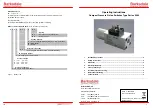
l
Single token bucket
The single token bucket technology uses the following parameters:
–
Committed burst size (CBS): indicates the maximum volume of traffic that bursts in
bucket C, in bytes.
–
Committed information rate (CIR): indicates the rate of tokens that are put into bucket
C, that is, the average traffic rate allowed by bucket C, in kbit/s.
If there are sufficient tokens in the bucket, packets are forwarded. At the same time, the
number of tokens in the bucket decreases based on the length of the packets. If there are
no tokens in the bucket, packets are discarded.
l
Dual token buckets
The dual token bucket technology uses the following parameters in addition to the CIR and
CBS:
–
Peak burst size (PBS): indicates the maximum volume of traffic that bursts and exceeds
the CBS in bucket P, in bytes.
–
Peak information rate (PIR): indicates the rate of tokens that are put into bucket P, that
is, the average traffic rate allowed by bucket P, in kbit/s.
For the dual token buckets:
–
The service traffic that is less than the CIR value is colored green and is allowed to pass
through.
–
The service traffic that exceeds the PIR value is colored red and is discarded.
–
The service traffic that ranges from the CIR value to the PIR value is colored yellow
and is discarded when congestion occurs.
Traffic Policing Features Supported by the S3700
The S3700 supports the following traffic policing features:
l
Interface-based traffic policing.
Interface-based traffic policing controls all incoming traffic on an interface regardless of
packet types. It discards the excess traffic, limits traffic within a proper range, and protects
network resources and carriers' interests.
l
Traffic policing based on a traffic classifier
Traffic policing based on a traffic classifier limits the rate of the traffic matching a traffic
classifier. The S3700 limits the rate of incoming traffic. It discards the traffic that exceeds
the rate limit, limits traffic within an appropriate range, and protects network resources and
carriers' interests. Traffic policing based on a traffic classifier uses dual token buckets.
After traffic policing based on a traffic classifier is configured on an S3700HI, CAR can
be performed twice for upstream flows. The S3700HI first applies CAR to the upstream
flows that match a traffic classifier, and then it aggregates all the upstream flows and applies
CAR to limit the aggregated flows. The upstream flows refer to the incoming service flows
matching a traffic classifier that is bound to a traffic behavior containing aggregate CAR.
NOTE
l
Aggregate CAR supports only the single token bucket.
l
Traffic policing based on a traffic classifier on the S3700HI implements interface-based and
flow-based rate limiting in both directions. The matching rule is set to
if-match any
.
S3700HI Ethernet Switches
Configuration Guide - QoS
2 Traffic Policing and Traffic Shaping Configuration
Issue 01 (2012-03-15)
Huawei Proprietary and Confidential
Copyright © Huawei Technologies Co., Ltd.
54
















































